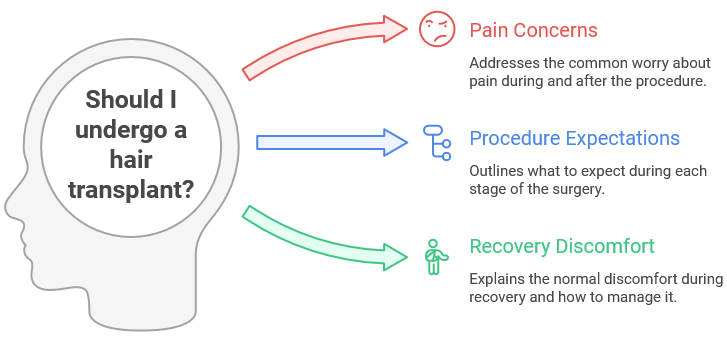If you’re thinking about getting a hair transplant, you’re probably worried about pain. Around 700,000 people get a hair transplant every year, and most of them ask the same question: Does a hair transplant hurt? Every person responds to pain differently, but the short answer is no.
Today, reputable hair transplant clinics use modern techniques like FUE (follicular unit extraction) and FUT (follicular unit transplantation) to make the hair restoration procedure as comfortable and painless as possible. For maximum comfort, doctors also administer local anesthesia.
Nevertheless, it’s natural to feel worried about pain sensitivity during and after hair transplant surgery. Don’t worry. We have answers to all your questions, from what happens in the surgery room to how your scalp feels while in recovery. Here’s what to expect from your hair transplant.
Is a Hair Transplant Painful?
Hair transplant surgery is not painful, at least not for most people. The majority of patients report little or no pain or discomfort during the procedure. Surgeons make sure the entire experience is pain-free by administering local anesthesia to numb both the donor and recipient areas.
Here’s what you can expect:
- Before anesthesia, you will likely feel a slight pinch from numbing injections.
- During surgery, most patients feel numbness, light pressure, or tugging.
- After surgery, you may experience mild soreness, swelling, or tightness.
The most uncomfortable you will be is during recovery, when your donor and recipient areas may feel sore or start to swell. Mild pain is normal in the first few days. Most doctors are transparent about that and recommend taking over-the-counter pain relievers to manage the pain.

What to Expect During the Procedure
For many people who decide to undergo this surgery, hair transplantation is the first surgical procedure they experience. Anxiety is common and understandable. To ease your worries and help you relax, we have prepared a quick breakdown of each stage of a hair transplant surgery:
1. Consultation & Planning
Before surgery, the doctor will determine your hair loss pattern, analyze follicle health, and discuss your expectations. Based on this initial consultation, the hair transplant surgeon will devise a restoration plan for your unique case and recommend a technique and the number of grafts.
2. Administering Local Anesthesia
As surgery starts, you will feel a sharp sensation as a few small injections numb the donor area and recipient sites. This is typically the only part where you feel a sharp sensation.
3. Extraction of Hair Follicles
The extraction of hair follicles depends on the hair transplant method recommended by the doctor. If your surgeon is performing an FUE hair transplant, your follicles will be removed one by one using a special micro-punch tool. If you’re receiving a hair transplant using a FUT hair transplant technique, a thin strip of scalp will be removed from your donor area and then dissected into hair grafts. Both are mostly pain-free.
4. Implantation of Hair Grafts
At this point, the doctor will make tiny incisions in the bold areas and carefully insert healthy follicles. The best hair transplant experts know how to plant follicles in a way that matches the natural direction of your hair growth, so that the end result doesn’t have a wig-like appearance.
5. Post-Procedure Dressing
When surgery is over, your doctor’s team will gently clean your scalp and cover the affected areas to allow them to heal without any risk of infection or transferred follicle damage.
Does Discomfort Influence the Results?
Some people believe that painful recovery lowers the quality of hair transplant results. Luckily, this is only a misconception. Pain and discomfort during recovery are normal, unless they are excessive or last for more than a few days. This sometimes happens when patients ignore the doctor’s instructions and scratch their scalp during the healing process, which could open wounds and cause infections.
Potential Risks and Side Effects
Getting a hair transplant from a reputable doctor is safe, but it’s important to be informed and know the potential side effects, from commonly occurring to rare and potentially harmful:
Possible Effect | How Common | How Long Does It Last | Management |
Mild swelling | Common | 2–4 days | Cold compresses, anti-inflammatory meds |
Scalp tenderness | Common | Up to a week | Over-the-counter painkillers |
Temporary numbness | Common | Few weeks | Resolves on its own |
Itching or redness | Common | 5–7 days | Moisturizing sprays, gentle care |
Infection or scarring | Rare | Variable | Antibiotics or corrective procedures |
Support and Expertise at the Clinic
Not all hair transplant clinics strive to provide the same level of comfort and quality, so how you choose makes a lot of difference. For example, a hair transplant in Turkey includes:
- Highly skilled surgeons with international accreditation.
- State-of-the-art facilities and medical equipment.
- All-inclusive packages with aftercare and support.
- Transparent, upfront pricing with no hidden costs.
The better the clinic, the less likely your hair transplant surgery will hurt. Pain-free surgery is ensured by the doctor’s experience and skill, as well as the medical team’s attentiveness and how they treat each patient. Always go for a top-rated clinic with many positive reviews.
FAQs
How long does recovery usually take after a hair transplant?
Hair transplant recovery typically lasts 7-10 days, during which many patients experience discrete pain and swelling.
Will I need more than one hair transplant session?
The number of hair transplant sessions and grafts depends on your hair loss pattern and phase. This will be determined by your doctor during the initial consultation.
Are there activities I should avoid after the procedure?
Hair transplant doctors typically recommend avoiding heavy exercise, swimming, and exposure to direct sunlight for the first 10-14 days after surgery.
How soon can I see visible results?
The first results of a successful hair transplant can be noticed in 6-9 months, while full results are visible after a full year.
Is everyone a good candidate for a hair transplant?
In most cases, the only requirement for a hair transplant is enough healthy hair follicles in the donor area, but hair restoration clinics can turn you down for other reasons, as well, based on their internal policy.
